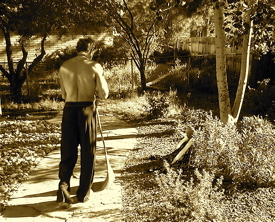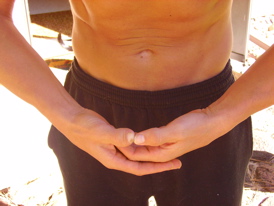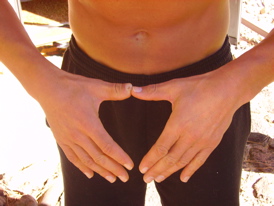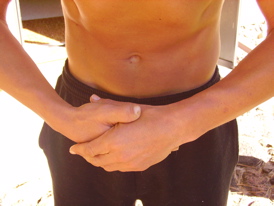Wholistic Fitness Meditation Teachings
by coach ilg
KIN-HIN WALKING MEDITATION
Coach ilg, in a popular DL photo, shown using a Kin Hin Walking Meditation while performing a Ritual Sweeping of the WF Temple’s BuddhaWalk pathway.
***
The Kin-Hin Teachings have long had their roots in WF Studies. Kin-Hin means, “Paying Attention,” and is essentially a type of ‘walking zazen.” It’s like a Tai Chi stroll! It is part and parcel of formal Zen Training where students sit for anywhere from 45-90 minutes or longer and then finally are allowed to stand up, and ceremoniously begin a very detailed mindful walk around a prescribed course.
I learned Kin-Hin from the various Zen Practice that undermined my earliest years as a spiritual athlete. It is not uncommon for a student to attempt to stand for Kin-Hin only to find themselves reeling ass-over-elbows falling down on legs that are numbed and too pained to stand! Humility must be often embraced in the Zen practices.
WF is the only personal training system that incorporates Kin-Hin into something as Western as the gym! Since 1983, I have have kept my original: “Kin-Hin Recovery Technique” as part of my WF Strength Training Disciplinary Studies. You may wish to review my books for refresher course on that noble “Iron Temple” teaching!
*** THE ROLE OF KIN-HIN in WF MEDITATION STUDIES
The use of Kin-Hin in our Meditation Studies is often performed as a type of “leg shake-out” during our Zazen or Pranayama sessions in this Path. Though Kin-Hin may indeed serve to restore circulation to legs that have fallen asleep during the cross-legged segments of a WF Meditation, the action of Kin-Hin is NOT a recovery for the mind! Very important to keep the mind focused on what your Teacher instructed you to focus upon during the Kin-Hin.
Traditionally, we use the WF Sacred Mantra, syllabically, to match each footstep with a syllable of the Sacred Mantra. See below.
***
HOW TO: TRADITIONAL WF USE of the KIN-HIN WALK during MEDITATION SESSIONS
1) Sit your prescribed Pranayama posture or, if sitting Zazen, use Zazen Mudra:

When in Zazen, use this hand posture. Right hand
underneath left, thumbtips barely touching, elbows float
off to the sides of the body, palms turned gently toward
Manipura Chakra (Naval Center). NOTE: only for photographic reasons
am i standing; this mudra is always done in Practice as a sitting hand gesture.
2) Upon reaching the intermediate time between your sitting session, begin a Kin-Hin Walking Meditation by arising as elegantly as possible from your sitting posture (May the Gods Be With You!), then bring hands back into Zazen Mudra (above) while standing in front of, or at the side of your Sitting Cushion. Mindfully, bring hands into the Transition Mudra:

Transition Mudra; thumbtips do not leave their Zazen Mudra contact while
you ‘spin’ your hands away from another to form a “heart” symbol.
3) From Transition Mudra, slowly and mindfully swivel the left hand on top of the right, and then slide the nests of the thumbs together so the thumbs interlock. This is your Kin-Hin Walking Meditation hand posture known as Sassho Mudra:

Sassho Mudra; thumbs interlocked, hand posture is reversed from Zazen Mudra. You are READY TO WALK!
4) Begin a mindful walk (usually toward your left) by lifting your left foot first, turning to face left, letting the heel kiss the earth first, then following suit with the right leg. Begin walking mindfully and elegantly for a total of 3 “laps” around your sitting space; first lap for Buddha, second lap for Dharma, third lap for Sangha.
Each time a foot contacts the earth, connect it with a syllable from the WF Sacred Mantra: OmManiPadmeHung.
Thus:
* Begin with Left Heel/Left Foot = OM
* Right foot = MAH
* Left foot = KNEE
* Right foot = PADH
* Left foot = MAY
* Right foot = HUNG
then repeat the Mantra:
* Left foot = OM
* Right foot = MAH
* Left foot = KNEE
* Right foot = PADH
etc, etc.
5) After completing 3 Laps of Kin-Hin Walking Meditation, return to your sitting cushion, elegantly sit down, reverse your leg posture from your first sit, and revert the Hand Mudra postures above so that you are back with Zazen Mudra for your second sit.
6) To end your session, perform 3 final laps of a Kin-Hin before bowing to your Puja Table (or whatever is in your Sitting Space) and Taking Leave of the session.
***
ADVANCED NOTES
If doing more than 2 consecutive sitting sessions, repeat Kin-Hin for each.
For you hard-core Zazen Athletes (and i have known a few!) raise from your cross-legged sitting posture directly into a pre Kin-Hin standing posture without letting your hands disturb the Zazen Mudra.
Commonly, an eneregetic sphere or ball will ‘gather’ in the space between a Zazen or Sassho Mudra and Manipura Chakra. Do not be distracted by this energy ball.
Poor Kin-Kin attributes include; wavering arms and hands, sloppy spine, inability to properly pace when walking with others, too ‘loud’ on the feet, not enough “Tai Chi” attitude in the stealthy walking of Kin Hin, distracted ears, distracted eyes, distracted smell, and the big one; distracted mind. Remember, Kin Hin should be a Wallking Zazen. Still mind; active body! Are you starting to Connect The Dots on how i “invented” WF Teachings from my spiritual upbringing in Zen?
***
SUMMARY
A description of the venerable Kin-Hin Walking Meditation history within Wholistic Fitness, attitude, and techniques of Kin-Hin specific to the Wholistic Fitness® Personal Training System. Kin-Hin has been a pivotal Practice of WF since 1983 and her teachings have permeated all of our Four Lifestyle Principles and our Five Fitness Disciplines!
Om Namah Kin-Hin!!!

 These teachings are the "Rasas" or "sap" of Wholistic Fitness. You’ll find insights to ponder, student chi to keep your own chi topped off, and plenty of proven training techniques to test on your own body, mind, and spirit! Also, you’ll find my very popular Race Reports, and news of our Sangha’s (community’s) latest transpersonal fitness adventures!
These teachings are the "Rasas" or "sap" of Wholistic Fitness. You’ll find insights to ponder, student chi to keep your own chi topped off, and plenty of proven training techniques to test on your own body, mind, and spirit! Also, you’ll find my very popular Race Reports, and news of our Sangha’s (community’s) latest transpersonal fitness adventures!